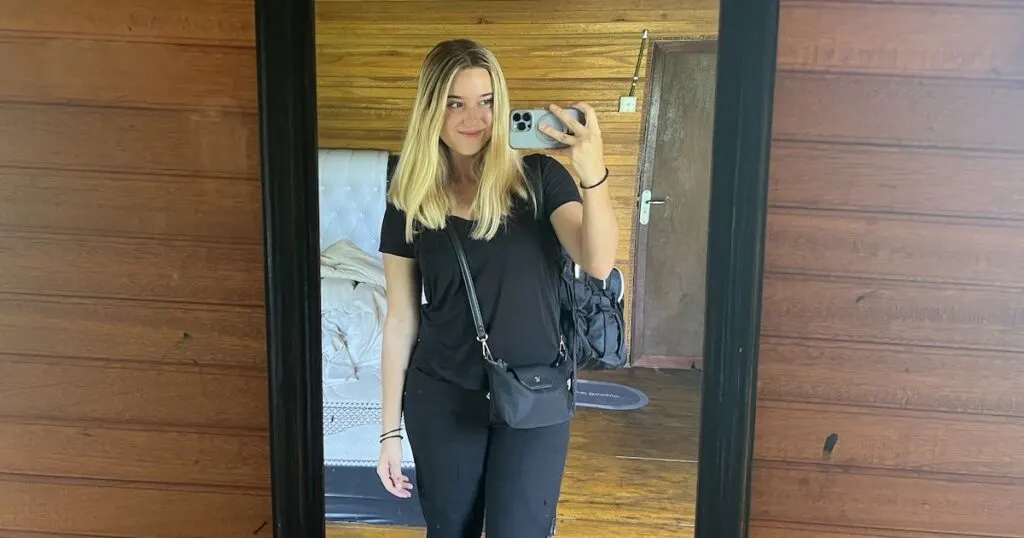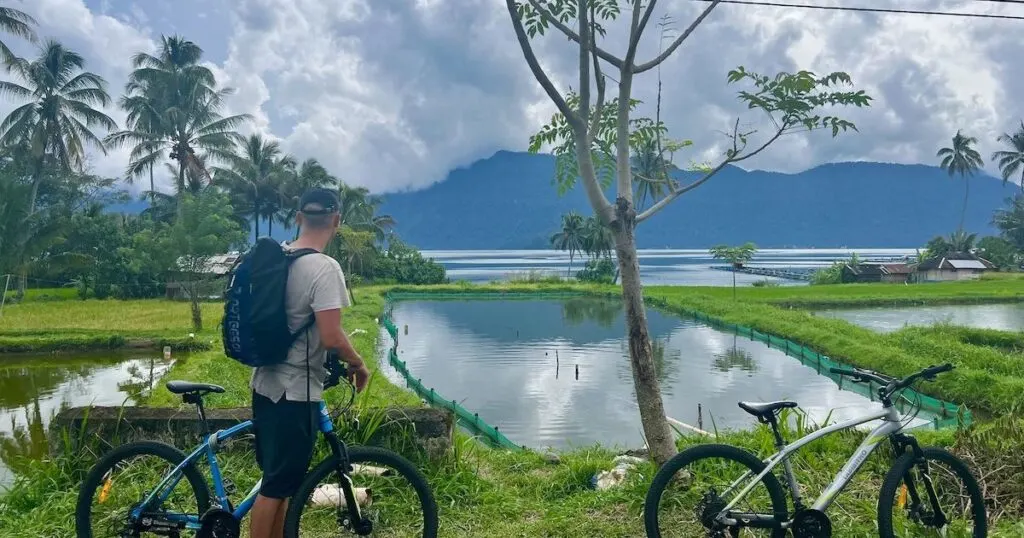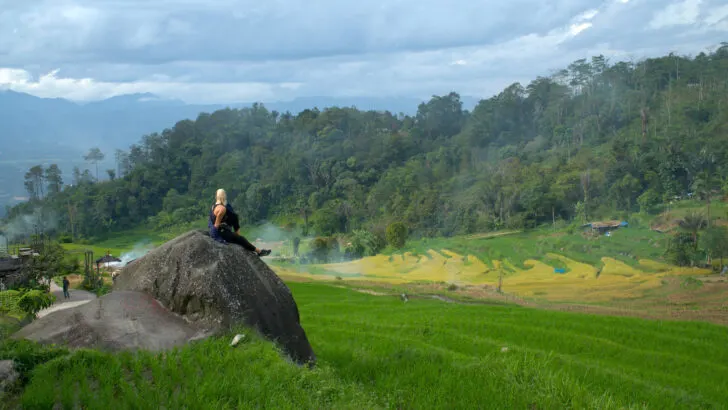If you’re pondering over what to wear in Sumatra, then you’re not the only one.
I spent very little time thinking about my Sumatra packing list – and as a result, I had to buy extra clothes on the island after quickly finding out I didn’t have enough long sleeves.
Sumatra is a challenging but rewarding place to visit in Indonesia, and one of those challenges is wearing long-sleeved clothes in hot, humid conditions.
As a predominantly Muslim island, it’s best to cover your shoulders, cleavage, belly, and knees.
In the following blog post, I’ll explain how which destinations you choose will impact your Sumatra packing list – for example, Lake Toba is a predominantly Christian area, so the dress code is more relaxed.
I’ll also talk about what to wear in West Sumatra versus North Sumatra. I’ll also talk about my experience and what I wore in both areas.
Looking for a full guide to Sumatra? Check out my Sumatra backpacking itinerary for an in-depth guide to north and west Sumatra.
Disclosure: This post includes affiliate links. If you decide to click through and make a qualifying purchase, I will receive a small commission at no extra cost to you – thanks for your support.
Don’t miss these experiences…
1. Overnight orangutan trekking (from Bukit Lawang or Medan) – likely to sell out!
2. Hike Mount Sibayak at sunrise (from Berastagi or Medan) 🌋
3. The famous five-day Mentawai tribe tour
Where is Sumatra?
Indonesia, the largest archipelago in the world, has five main islands and 18,110 small islands and islets.
Sumatra is the largest of them all.
In fact, it’s the sixth-largest island in the world.
Sumatra is just east of Peninsular Malaysia and north of the Indonesian island of Java.

Sianok Canyon in Bukittinggi, West Sumatra
There are ferry connections between Sumatra and Malacca in Malaysia.
However, most people prefer to fly there because the ferry port is in Dumai on the east coast of Sumatra, and from there, it’s a long bus ride to north or west Sumatra.
What is the Climate Like in Sumatra?
Sumatra has a tropical climate. The average temperature in Sumatra is 32 °C (90 °F).
Conditions are hot and humid pretty much all year round, although there are two distinct seasons: dry and rainy.

Harau Valley, West Sumatra
The temperature depends upon the altitude of your destination too.
There are lots of highland areas in Sumatra, where the temperature is a little more moderate (20 – 28 °C).
The dry season is from February and August.
The wet season is from September to January.
There is also a burning season, which you will want to avoid due to the poor air quality.
This is from June to October, but sometimes varies depending on when the farmers start burning their crops.
Ramadan also happens once per year. During this time, restaurants are closed until sunset. Most homestays will provide food but note that it is difficult to find substantial food at local restaurants unless you are travelling in Christian areas such as Lake Toba.
What to Wear in Sumatra

I’m going to simplify what to wear in Sumatra into four simple points:
1. Cultural expectations
Sumatra is a predominantly Muslim country. This is especially true of West Sumatra, where the population is 99% Muslim.
There are Christian enclaves in north Sumatra, mainly at Lake Toba (among the Batak Toba, Karo and Pakpak groups) and the Nias Islands (95% Christian population).
In these enclaves, it is more acceptable to reveal your shoulders, chest and knees, as well as to wear a swimsuit, swim shorts or a bikini.
However, in the rest of Sumatra, I recommend that you dress modestly to avoid offending locals and attracting unwanted attention.
2. Climate and weather
If you’re not used to being in a tropical climate, the likelihood is that you will sweat a lot in Sumatra.
It’s important to wear quick-drying, breathable clothes. Linen, cotton and quick-dry sports materials are ideal.
As you’ll be dressing conservatively, you will also want to wear clothes that don’t stick to your skin.
Baggy and loose-fitting trousers, skirts, blouses, and shirts are a good idea.
Even in the dry season, I also recommend that you carry around a lightweight waterproof jacket because Sumatra can be prone to sudden downpours.
3. Activities
In Sumatra, you might want to try orangutan trekking in Bukit Lawang or hiking in the Harau Valley.
While it may be tempting to take off your long sleeves, you should do the opposite.
In the rainforest, there are huge mosquitos which will bite you if you have exposed skin – and there’s a good chance they’ll bite you through tight-fitting leggings too.
Loose, long-sleeved clothing coated in mosquito repellent is essential – I learnt my lesson the hard way.
What to Wear in Sumatra: Outfit Ideas
First things first, I want to make it clear that I have seen tourists wearing shorts, crop tops, and tight-fitting clothes in Sumatra, even in West Sumatra.
However, my problem with that is that it can offend locals. It can also draw unwanted attention if you’re a woman.
In my experience, people in Sumatra were very friendly, interested in talking to us, and willing to help if they spoke English.
I also had several people express to me that they were happy that I dressed modestly.


Dressing conservatively is the simplest way to say, “Hey, thank you for letting me explore your home. I don’t want to offend you – and I’m happy to be here.”
You don’t need to wear a headscarf if you’re a woman, as not all women in Sumatra wear the hijab.
Here’s what you can do:
- Cover the shoulders, chest, and knees: These are the main rules to follow. Also, avoid backless tops.
- Avoid see-through clothing: Lighting can change how see-through the material is, as does bending over. Thoroughly check that your clothes are not see-through before travelling.
- Don’t wear tight-fitting clothing like leggings, unless your hips/behind are covered by a baggy top.
- If in doubt, copy the locals. If you’re not sure what to wear, just look at what the locals are wearing. If women are wearing short sleeves and long trousers, that’s a good idea. If the men are wearing shorts, then you should be okay doing that too.
Outfit for Women in Sumatra

My go-to outfit in west Sumatra: Linen trousers and a cotton t-shirt.
- Lightweight trousers and a cotton t-shirt (covering the shoulders).
- T-shirt blouse and trousers.
- Full-length vest top, long-sleeve blouse, and trousers or a maxi skirt.
- Maxi-length t-shirt dress.
- Below-the-knees skirt and a lightweight t-shirt blouse.
Outfit for Men in Sumatra

- Lightweight tracksuits and a t-shirt.
- A loose shirt and linen trousers.
- Loose shorts (covering the knees) and a t-shirt.
What to Wear in North Sumatra
North Sumatra is predominantly Muslim. You should dress conservatively.
However, there are Christian enclaves, where it is acceptable to dress slightly less conservatively, like Lake Toba.
What to Wear in Lake Toba
Lake Toba is a predominantly Christian area. It is also one of the most touristic parts of Sumatra, as the largest volcanic crater lake in the world.
It is common for tourists to wear a bikini, swim shorts, or a swimming costume to swim in the lake, and locals don’t bat an eye.

Swinging on a tyre swing at Reggae Guesthouse on Samosir Island in Lake Toba
The Christian community at Lake Toba practises dressing modestly, but it is not as strict.
What to Wear for Jungle Trekking in Bukit Lawang
The main challenge when going jungle trekking in Bukit Lawang is mosquitos.
Long trousers and a long-sleeved top coated in mosquito repellent are essential. It may be tempting to wear a t-shirt, but you will only emerge with mosquito bites.

Sturdy hiking boots or good trainers are a must because the jungle has uneven surfaces, mud, and streams.
You should also wear long socks to cover any exposed skin around the ankles because there are leeches in the jungle.
What to Wear in West Sumatra
What to Wear in Bukittinggi
Bukittinggi is a very conservative Muslim city.
You should be extra careful here to dress modestly and cover your knees, shoulders and chest at all times.

What to Wear in Harau Valley
The Harau Valley is also very conservative. You will need to cover your knees, shoulders, and chest.
At Abdi Homestay, I felt more comfortable dressing slightly more ‘Western’.
For example, I wore a dress slightly above my knees and once or twice, I wore a crop top.

Still, the homestay has visitors, and I spotted a visitor taking photographs of me when I had my shoulders exposed.
What to Wear in Lake Maninjau
Lake Maninjau is a conservative Muslim area.

You should cover your knees, shoulders and chest at all times, even if you’re cycling around the Lake.
What to Wear on the Mentawai Islands
The Mentawai Islands are not predominantly Muslim, although there are small Muslim and Christian communities on the islands.
The islands predominantly believe in animism, the belief that all humans, animals, natural objects, and geographic features (such as volcanoes) are inhabited by a spirit.
This, combined with the fact that the islands are visited by surfers who wear bikinis and swimming shorts freely, means that you don’t necessarily need to dress conservatively on the islands.
You should feel quite comfortable exposing your shoulders and knees and wearing a bikini, swim shorts or a swimsuit on the beaches.
What to Wear in Sumatra: Sumatra Packing List
First… How to find mosquito repellent in Sumatra
The most important thing to include in your Sumatra packing list is mosquito repellent. Mosquitos may carry malaria in Sumatra.
I ran out of mosquito repellent in west Sumatra and spent three days struggling to find mosquito repellent.
Shop workers and pharmacists had little understanding of where to find mosquito repellent that could be applied directly to the skin. Coils were more common.
Fragranced mosquito repellent sachets are also sold in some pharmacies but they aren’t very effective.
Eventually,I found Soffell and Autan mosquito repellant in a large supermarket in Payakumbuh, the town nearest to the Harau Valley.
Both of the Autun formulas worked well on skin and clothes, and lasted overnight. However, the Soffell brand didn’t work very well for me.

When you’re choosing what to wear in Sumatra, apply a coat of mosquito repellent to your clothes too.
I hope you found my guide to what to wear in Sumatra useful! Have a great trip.
Tourists in Indonesia should dress conservatively by covering the knees, shoulders and chest because Indonesia is a predominantly Muslim country. In Bali, tourists don’t need to cover up.
While you can wear shorts in Bali, wearing shorts on predominantly Muslim islands such as Sumatra or Java is less advisable. If you wear shorts, they should be below the knee. Men can wear shorts that don’t show the majority of the thigh.


Siddharth (bucketlistsid)
Thursday 15th of June 2023
Beautiful read Kaite! Took me like 10 mins or more to be able to grasp everything and mind-mapping everything up! Super detailed and cannot wait to visit Sumatra.